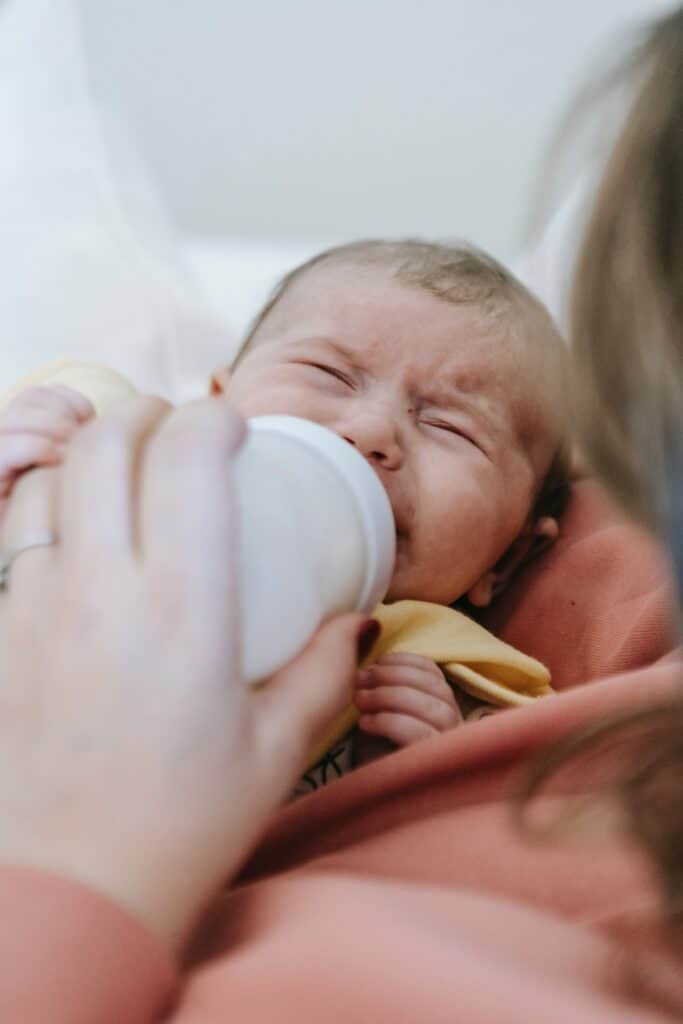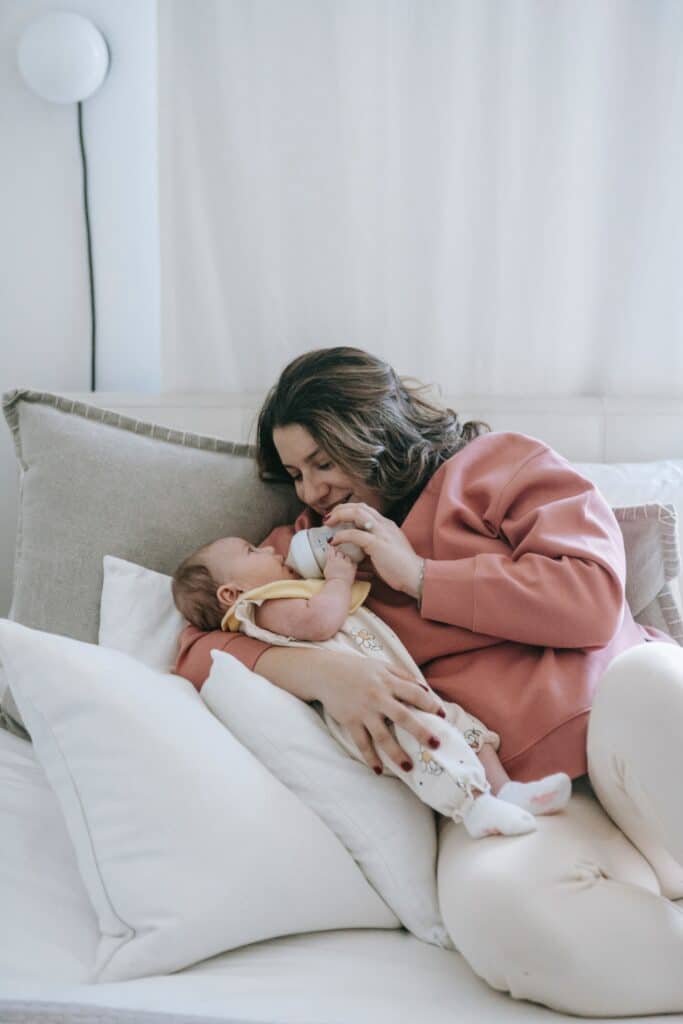The question of should you change your baby’s diaper before or after feeding suddenly becomes very important at 3 a.m. and you’d do anything to get back to sleep quickly.
There are some cases, such as a very wet, soiled, or leaking diaper that means you should change first; otherwise, it really depends on the situation. If you want your baby to fall asleep after feeding – especially if it’s the middle of the night – you should change their diaper first or try a feeding sandwich so they are relaxed and ready for sleep.
Read on to learn more about different situations where you might feed or change a diaper first.
Table of Contents
Should you change your baby’s diaper before or after feeding?
There is not a single, straightforward answer as to whether you should change your baby’s diaper before or after feeding them, but there are some clear scenarios where one may be a better choice. It all depends on what the parent most wants to accomplish.
If it’s daytime, you should check to see if the diaper is soiled or overly wet; if not, feel free to go ahead and feed your hungry baby. Your priority is likely to stop the crying as soon as possible.
If, however, it’s nighttime and you want your little one to go back to sleep easily, you should change the diaper first (or before switching sides if you’re breastfeeding) so your baby can relax and fall asleep while feeding. That’s because your priority is getting that baby back in their crib so you can go back to sleep.

There are of course situations where an immediate diaper change is necessary. If a diaper is full, or your baby has a blow out then of course you would change it before feeding them.
Another situation where a diaper change may need to be first is if your baby has sensitive skin. Diaper changes were done always first to prevent irritation.
Should I change the baby’s diaper after every feeding?
With a newborn, you will most likely change your baby at every feeding but an older infant will need less frequent diaper changes. This means that as your baby ages, they will not need a change at every feeding.
In the newborn days, your baby will usually need a diaper change every two to three hours. This will change as your baby gets older since as they get older and their digestive systems mature, babies will start pooping and peeing less often.
To be on the safe side, I would check the diaper before feeding and then after to see if a change was needed. You will also learn your baby’s patterns and will be able to predict more accurately when they’ll need that change.
Changing diapers before or after feeding
From talking to other parents, reading various parenting forums, and from personal experience, most seem to agree with changing a diaper before feeding, especially with younger infants.
There are definitely situations where diaper changes are needed after feeding, but most people seem to feel that changing a diaper beforehand is the best way. One reason many parents prefer this is that it tends to make the baby more comfortable. Many babies will not settle down to eat until their diaper is changed.
There is no “wrong” way to do this, however. It varies by baby, parent, and situation. Most parents will have a preference but specific situations will occur where they may decide to change the order of things.
Changing baby’s diaper first
When a baby needs both at the same time, there are situations where changing a diaper first would be absolutely necessary.
Always change your baby’s diaper before feeding if:
- the diaper is full
- there is poop
- there is leakage.
Leaving a baby in a full diaper for too long, even if it’s just pee, could also be harmful since that gives bacteria a place and a chance to grow. This could lead to urinary tract infections as well as diaper rashes.
For babies with sensitive skin or those who are prone to diaper rashes, it would be especially important to change poop diapers first before feeding. Babies who have a current rash would also need to be changed to prevent bacteria from causing a bigger infection.
In these situations, your baby might feel highly uncomfortable and would want their diaper changed immediately. Also, there is the mess factor or the parent as well. Trying to feed a baby with a diaper or outfit that’s soaked with pee would create a bigger mess.
Benefits of changing baby’s diaper after feeding
There are also times when it’s important to feed the baby first.
Situations where you may want to feed your baby first, include:
- Your baby is super hungry and the diaper is not in dire condition.
- If your baby doesn’t have a soaking diaper and you want to keep them up for longer periods of time
- If your baby tends to poop at the end of a feeding
- When it’s more convenient overall
Often sleepy babies may stay up longer if they get a diaper change second. Many parents do this when they want to try to keep a baby awake longer and it is mostly done during the day.

Feeding sandwich
For many babies, changing their diapers tends to wake them up more. In that case, you might want to consider a “feeding sandwich.”
The feeding sandwich is when you feed your baby, pause halfway through to change their diaper, then continue the feeding. Nursing mothers will usually use this technique and change the baby before switching sides. For bottle-fed babies, parents just watch the bottle to be half-finished before pausing to do a quick diaper change then let the baby finish the bottle.
Here is when many parents would opt for this:
- In the middle of the night if a baby needs to be changed
- If the baby is about to go down for a nap
Both these options center around sleep. By sandwiching the change in between feeds the baby is able to drift back to sleep without the jostling of the diaper change before being placed back in the crib.
The best time to change a baby’s diaper during a night feed
When it comes to night changes, many parents opt for either changing a baby’s diaper first or doing the sandwich feed (feed, change, feed). There are very good reasons for both techniques.
When a parent changes the baby’s diaper first the baby is jolted awake and is more alert, making feeding them easier. This is especially important during the newborn days when it is recommended that the baby eat every 2 to 3 hours. According to the Mayo Clinic, waking a newborn to eat is important until they are back up to birth weight and establish a specific weight gain pattern.
When a baby is super hungry in the middle of the night, the sandwich feed is highly recommended. This way, the baby can eat and calm down before a diaper change and then finish eating once clean. The second portion of the feeding can help put them back baby to sleep.
The consensus among many of the parents is to try to avoid changing diapers in the middle of the night if possible. This may cause your baby to become more awake and alert, leading them to play instead of going back to sleep.
To prepare for the inevitable nighttime diaper changes, though, read my tips to help your baby not hate diaper changes.
Do I have to change a newborn’s poopy diaper right away?
It’s considered best practice to change a soiled or wet diaper as soon as possible. Of course, you can use discretion. Sometimes baby poops right after diaper changes because they get stimulated or surprised by the cool air on their bottoms. If you’re just sitting down for a feed, it’s fine to go ahead and finish that. However, don’t go about your day or wait several hours.
Infrequently changed diapers cause diaper rash. Besides being painful for your baby, diaper rash can lead to fevers and further infection if not properly cared for.
In general, newborn diaper change frequency is higher than that of older babies.

Other nighttime diaper change tips
Most parents wonder about the diaper versus feeding balance in the context of making the nights easier for both parents and the baby. Here are my best tips for navigating those middle-of-the-night wake-ups:
- Leave pee-only diapers alone. Use a barrier cream to prevent diaper rash. However, if your baby has open sores or already has diaper rash, do change as soon as possible regardless of the time of day.
- Do not make eye contact. It encourages play and interaction
- Keep the lights off. Consider sticking a small rechargeable light near the changing table so you can see what you’re doing without turning on the overhead light.
- Make sure you’re using well-fitting diapers. Diapers that are too big or too little tend to leak.
- Change the diaper before putting your baby down for the night.
- As your baby gets older, consider overnight diapers with added absorbency to prevent leaks.










